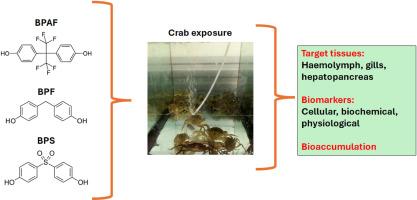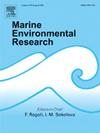Effects of Bisphenol A analogues and their mixture on the crab Carcinus aestuarii: Cytotoxicity, oxidative stress and damage, neurotoxicity, physiological responses, and bioaccumulation
IF 3
3区 环境科学与生态学
Q2 ENVIRONMENTAL SCIENCES
引用次数: 0
Abstract
Bisphenol A (BPA) analogues are emerging contaminants, whose ecotoxicological profile for aquatic species, particularly marine ones, is little known. In this study, the effects of an environmentally realistic concentration (300 ng/L) of three BPA analogues (BPAF, BPF, and BPS) - alone or as a mixture (MIX) – were evaluated for the first time on the crab Carcinus aestuarii. A multibiomarker approach was adopted to assess the effects of 7 and 14 days of exposure on haemolymph parameters, gill and hepatopancreas biochemical parameters, and physiological responses of crabs. Bioaccumulation of the three bisphenols was also investigated in crabs by UHPLC-HRMS. A significant reduction in total haemocyte counts was recorded in crabs exposed for 7 days to BPAF and MIX and for 14 days to the MIX, whereas an increase was found in crabs treated for 14 days with BPAF. Cell proliferation increased significantly in crabs exposed for 14 days to BPS and MIX. An imbalance of the antioxidant system, as well as oxidative damage, was recorded in gills and hepatopancreas. No neurotoxic effects were observed in crabs. At the physiological level, exposure to MIX increased the respiration rate of crabs. As for bioaccumulation, only bisphenol AF was detected in crabs. Overall, the present study demonstrated that BPA analogues can affect some important cellular parameters, induce oxidative stress and alter physiological responses in crabs.

双酚 A 类似物及其混合物对鲤形目蟹的影响:细胞毒性、氧化应激和损伤、神经毒性、生理反应和生物累积。
双酚 A(BPA)类似物是一种新出现的污染物,其对水生物种(尤其是海洋物种)的生态毒理学特征鲜为人知。本研究首次评估了三种双酚 A 类似物(BPAF、BPF 和 BPS)单独或混合物(MIX)在环境中的实际浓度(300 纳克/升)对螃蟹 Carcinus aestuarii 的影响。采用多生物标志物方法评估了 7 天和 14 天接触对螃蟹血淋巴参数、鳃和肝胰脏生化参数以及生理反应的影响。此外,还通过超高效液相色谱-高分辨质谱法研究了三种双酚在螃蟹体内的生物累积性。螃蟹接触双酚 AF 和 MIX 7 天以及接触 MIX 14 天后,血细胞总数明显减少,而接触双酚 AF 14 天后,血细胞总数有所增加。接触双酚 AF 和 MIX 14 天的螃蟹的细胞增殖明显增加。在鳃和肝胰腺中记录到抗氧化系统失衡以及氧化损伤。在螃蟹体内没有观察到神经毒性效应。在生理层面,接触 MIX 会增加螃蟹的呼吸速率。在生物累积方面,仅在螃蟹体内检测到双酚 AF。总之,本研究表明,双酚 AF 类似物会影响螃蟹的一些重要细胞参数,诱发氧化应激,并改变螃蟹的生理反应。
本文章由计算机程序翻译,如有差异,请以英文原文为准。
求助全文
约1分钟内获得全文
求助全文
来源期刊

Marine environmental research
环境科学-毒理学
CiteScore
5.90
自引率
3.00%
发文量
217
审稿时长
46 days
期刊介绍:
Marine Environmental Research publishes original research papers on chemical, physical, and biological interactions in the oceans and coastal waters. The journal serves as a forum for new information on biology, chemistry, and toxicology and syntheses that advance understanding of marine environmental processes.
Submission of multidisciplinary studies is encouraged. Studies that utilize experimental approaches to clarify the roles of anthropogenic and natural causes of changes in marine ecosystems are especially welcome, as are those studies that represent new developments of a theoretical or conceptual aspect of marine science. All papers published in this journal are reviewed by qualified peers prior to acceptance and publication. Examples of topics considered to be appropriate for the journal include, but are not limited to, the following:
– The extent, persistence, and consequences of change and the recovery from such change in natural marine systems
– The biochemical, physiological, and ecological consequences of contaminants to marine organisms and ecosystems
– The biogeochemistry of naturally occurring and anthropogenic substances
– Models that describe and predict the above processes
– Monitoring studies, to the extent that their results provide new information on functional processes
– Methodological papers describing improved quantitative techniques for the marine sciences.
 求助内容:
求助内容: 应助结果提醒方式:
应助结果提醒方式:


